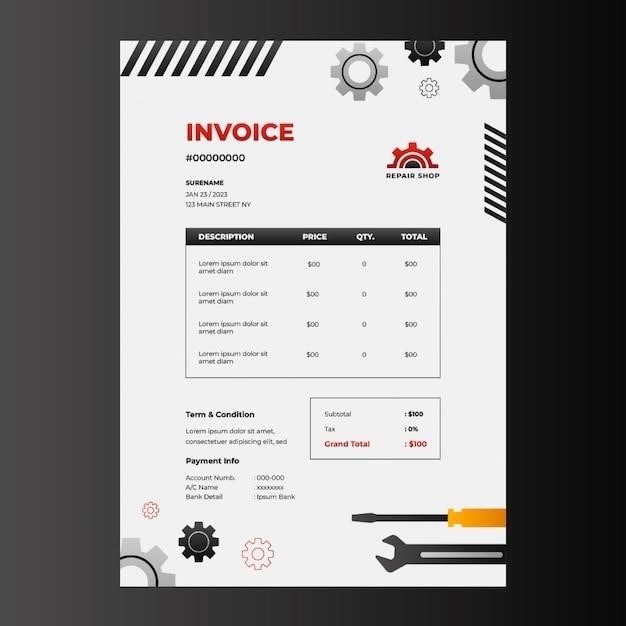NEMA Motor Frame Size Chart PDF⁚ A Comprehensive Guide
This guide explores NEMA motor frame size charts in PDF format, crucial for selecting and replacing electric motors. Understanding frame numbers, dimensions, and design types (A, B, C, D) is vital for proper motor selection and application. We’ll cover key manufacturers, online resources, and comparisons with IEC standards.
Understanding NEMA Frame Assignments

NEMA (National Electrical Manufacturers Association) frame assignments are a standardized system for classifying electric motor sizes. These assignments aren’t arbitrary; they directly correlate to physical dimensions and characteristics of the motor. The system simplifies motor selection and replacement, allowing for easy interchangeability between motors from different manufacturers, provided they share the same NEMA frame size. This standardization is critical for efficient maintenance, repair, and upgrades in industrial settings. A key aspect is the consistent relationship between the frame number and the motor’s shaft height (D dimension). This relationship is usually a simple calculation, often involving dividing the first two digits of the frame number by four to determine the shaft height in inches. This allows for quick identification of compatible motors within a specific application. Variations exist within the system, such as the “C-face” designation, indicating a specific flange mounting configuration. Understanding these variations is essential for accurate motor selection and installation. By comprehending the NEMA frame assignment system, users can quickly and confidently select replacement motors, ensuring compatibility and operational efficiency.
NEMA Design Types (A, B, C, D) and Their Significance
NEMA design types (A, B, C, and D) are crucial classifications within the NEMA motor frame size system. These designations don’t relate to physical size but instead specify the motor’s torque and speed characteristics. Type A motors, for instance, are characterized by their high starting torque, making them well-suited for applications demanding high initial power, such as conveyors or heavy machinery. Type B motors offer a balance between starting torque and running speed, representing a versatile choice across a range of applications. Type C motors prioritize high running speed over starting torque, making them suitable for applications where rapid acceleration isn’t paramount. Type D motors, in contrast, are specialized, designed for high-speed applications requiring minimal starting torque. The selection of the appropriate NEMA design type is critical for matching the motor’s performance profile to the specific demands of the application. Using the wrong design type can lead to inefficient operation, premature wear, or even motor failure. Therefore, understanding the nuances of A, B, C, and D designs is essential for optimal motor performance and longevity within any given industrial or commercial setting. Consulting a NEMA motor frame size chart that includes design type information is key for accurate selection.
NEMA Enclosure Standards for Electric Motors
NEMA (National Electrical Manufacturers Association) establishes comprehensive enclosure standards for electric motors, crucial for ensuring safe and reliable operation in diverse environments. These standards categorize enclosures based on their degree of protection against environmental factors like dust, moisture, and physical impacts. Common NEMA enclosure types include⁚ Type 1 (general purpose, indoor use), Type 3 (weatherproof, suitable for outdoor installations), Type 4 (watertight, resistant to splashing and hose-directed water), and Type 12 (dust-tight and drip-proof, ideal for indoor environments with potential for dust or condensation). Selecting the appropriate NEMA enclosure is vital for preventing motor damage, ensuring operational longevity, and maintaining safety. A motor operating in a harsh environment necessitates a higher level of protection than one used in a controlled setting. For instance, a Type 4 enclosure would be appropriate for a motor operating near a water source, while a Type 12 enclosure might be suitable for a motor in a dusty factory setting. The NEMA enclosure type is typically specified alongside the motor frame size, providing a complete picture of the motor’s physical characteristics and environmental suitability. Mismatching the enclosure to the operational environment can lead to costly repairs and downtime.
NEMA Motor Frame Variations and Designations (e.g., C-face)
Beyond the standard NEMA frame numbers, various design variations and designations exist, impacting mounting and other crucial aspects. The most common is the “C-face” designation, indicating a motor with a specific flange mounting pattern. This standardized flange allows for easy interchangeability among motors from different manufacturers, simplifying replacement and maintenance; Precise dimensions for the bolt circle and other critical features are defined within the NEMA standards for each frame size. Other variations might include different shaft extensions (e.g., single or double), specialized mounting feet, or modifications for specific applications. These variations are often indicated by additional letters or symbols appended to the standard frame number. For example, a “T” suffix could signify a motor with a particular thermal protection system. Understanding these variations is crucial for proper selection, ensuring compatibility with existing equipment, and avoiding costly errors during installation or replacement. Detailed specifications for these variations are typically found in manufacturer’s documentation or more comprehensive NEMA standards documents, going beyond the basic frame size chart. Consult these resources to ensure compatibility and proper functionality within your system.
Interpreting NEMA Frame Numbers⁚ Determining Shaft Height and Other Dimensions
NEMA frame numbers are not arbitrary; they directly relate to key motor dimensions. The initial digits typically represent the shaft height, often expressed in inches. For instance, a NEMA 324T motor has a shaft height of 8 inches (32 divided by 4). However, this is just one dimension. A comprehensive NEMA frame size chart will list many others, critical for proper mounting and integration. These include the mounting face dimensions (critical for C-face motors), overall motor length, and shaft diameter. The chart will also specify the location and size of mounting holes, ensuring precise alignment with the driven equipment. Some charts may further detail dimensions for specific motor variations, like those with extended shafts or specialized features. Always cross-reference the chart with the manufacturer’s specifications, as minor variations can exist. Using a reliable chart and manufacturer data is crucial to avoid costly mistakes and ensure seamless integration into your system. Remember that the frame number is a starting point; the complete set of dimensions is essential for proper installation and operational safety. Accurate interpretation of these figures is fundamental to successful motor selection and system design.
Finding and Using NEMA Frame Size Charts⁚ Online Resources and PDF Downloads
Locating comprehensive NEMA motor frame size charts is readily achievable through various online avenues. Manufacturer websites often provide detailed charts as PDFs, downloadable for convenient reference. These manufacturer-specific charts offer the most precise dimensions for their particular motor models, including any unique variations or design features. However, for a broader overview encompassing multiple manufacturers, searching online using keywords like “NEMA motor frame size chart PDF” yields numerous results, including those from industry associations and third-party resources. Be discerning when choosing a source; ensure the chart is up-to-date and from a reputable source to avoid inaccuracies. Many engineering resource websites also offer downloadable charts, often organized for easy navigation based on frame size or motor type. Once you download a chart, it’s crucial to understand how to interpret the information. Familiarize yourself with the various dimensions listed, including shaft height, mounting face dimensions, and overall motor length. Remember that charts may use different units of measurement (inches or millimeters), so pay close attention to the chart’s legend. Using these readily available resources ensures you have the necessary information for accurate motor selection and system design.
Key Manufacturers and Their NEMA Frame Offerings
Several major manufacturers offer a wide range of electric motors conforming to NEMA frame sizes. Prominent among them are Baldor-Reliance, a leading provider of industrial motors known for their comprehensive NEMA frame offerings, including various designs and horsepower ratings. Their extensive catalog and online resources make finding specific frame dimensions relatively straightforward. Similarly, WEG Motors, a global player in the motor industry, also provides a robust selection of NEMA-compliant motors. Their website features detailed specifications and dimension charts, assisting in motor selection and replacement. Other significant manufacturers such as Siemens, Toshiba, and US Motors are also key players in the market, providing extensive NEMA frame motor options. These manufacturers often have online tools or catalogs to aid in finding the correct frame size and specifications. However, it’s crucial to note that while these manufacturers adhere to NEMA standards, minor variations might exist between manufacturers due to design specifics or specialized features. Always refer to the manufacturer’s specific documentation for precise dimensions and performance details. Consulting the individual manufacturer’s websites or contacting their technical support is recommended for detailed information about their specific NEMA frame offerings and any potential variations.
Comparing NEMA and IEC Frame Sizes

NEMA (National Electrical Manufacturers Association) and IEC (International Electrotechnical Commission) frame sizes represent different standards for electric motor dimensions. NEMA frames are predominantly used in North America and utilize inch measurements, while IEC frames, employing metric measurements (millimeters), are the global standard. Direct comparison requires conversion between inch and metric systems. A NEMA frame number, such as 56C, doesn’t directly correlate to a specific IEC frame size. Instead, the physical dimensions (shaft height, mounting dimensions, etc.) must be compared. Online resources and conversion charts can assist in this process. While some manufacturers offer motors in both NEMA and IEC frames, ensuring compatibility requires careful attention to detail. Direct interchangeability isn’t guaranteed; variations in mounting patterns, shaft diameters, and other crucial dimensions can lead to incompatibility. Careful review of both the NEMA and IEC specifications is essential. ABB, for instance, has integrated IEC frame options into their motor-drive offerings, highlighting the growing need for cross-compatibility. However, simply matching horsepower ratings isn’t sufficient. A thorough examination of all relevant dimensions is crucial for seamless motor integration.
Applications and Considerations for Different NEMA Frame Sizes
NEMA motor frame size selection is crucial for optimal performance and efficiency. Smaller frames (e.g., 213, 215) are suitable for lower-power applications like small pumps or fans, where space is limited. Larger frames (e.g., 449T) handle higher horsepower requirements found in industrial machinery, such as conveyors or large pumps. Factors to consider include the required horsepower, operating speed, duty cycle, and environmental conditions. The motor’s mounting style (e.g., foot-mounted, face-mounted) is also influenced by the frame size, impacting installation and integration with equipment. Choosing a frame size too small for the application risks overheating and premature failure. Conversely, an oversized motor may be unnecessarily costly and inefficient. Consider the overall system design. External ventilation may impact the choice, as motors in enclosed spaces might necessitate a more robust, larger frame for adequate cooling. The required torque output is another critical factor; a larger frame generally delivers higher torque. Additionally, the motor’s enclosure type (e.g., TEFC, open) and its insulation class influence the appropriate frame size, impacting its ability to withstand harsh environments or high temperatures. Always consult the motor manufacturer’s specifications and application guidelines to ensure proper selection.
